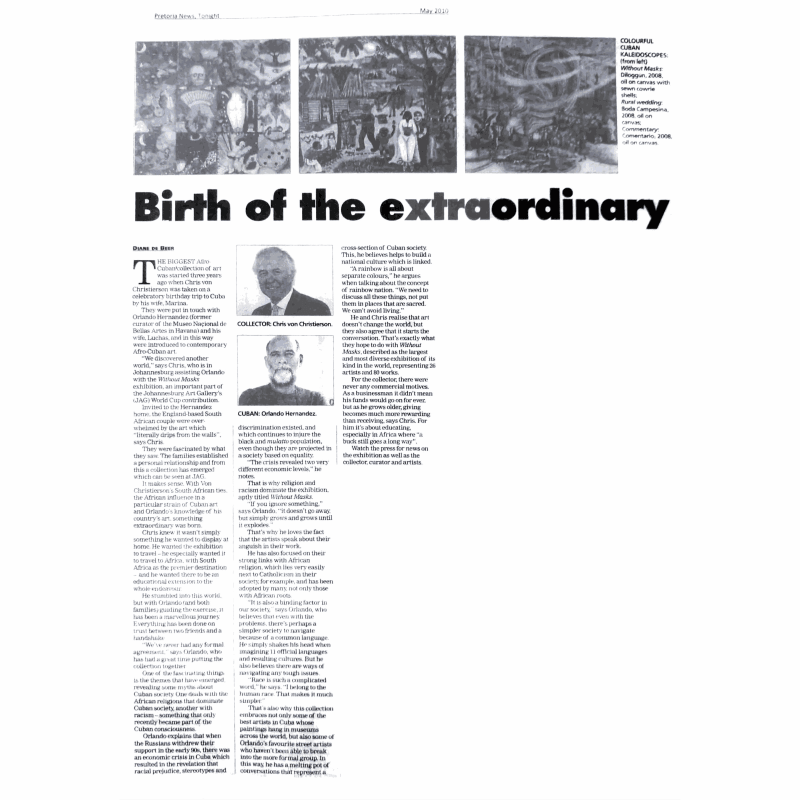THE BIGGEST Afro-Cuban collection of art was started three years ago when Chis Von
Christierson was taken on a celebratory, birthday trip to Cuba by his wife, Marina.
They were put in touch with Orlando Hernandez (former
curator of the Museo Nacional de Bellas Artes in Havana) and his
wife. Luchas, and in this way were introduced to contemporary Afro-Cuban art.
"We discovered another world." says Chis, who is in Johannesburg assisting Orlando with the Without Masks exhibition, an important part of the Johannesburg Art Gallery's (JAG) World Cup contribution.
Invited to the Hernandez home, the England-based South African couple were over
whelmed by the art which "literally drips from the walls", says Chris. They were fascinated by what they saw. The families established a personal relationship and from this a collection has emerged which can be seen at JAG.
lt makes sense. With Von Christierson's South African ties, the African influence in a particular strain of Cuban art and Orlando's knowledge of his country's art, something extraordinary was born.
Chris knew it wasn't simply something he wanted to display at home. He wanted the exhibition to travel - he especially wanted it to travel to Africa, with South Africa as the premier destination and he wanted there to be an educational extension to the whole endeavour.
He stumbled into this world, but with Orlando (and both families) guiding the exercise, it has been a marvellous journey. Everything has been done on trust between two friends and a
handshake. "We've never had any formal agreement," says Orlando, who has had a great time putting the collection together.
One of the is the fascinating things is the themes that have emerged, revealing some myths about Cuban society. One deals with the African religions that dominate Cuban society, another with racism-something that only recently became part of the Cuban consciousness. Orlando explains that when the Russians withdrew their support in the early 90s, there was an economic crisis in Cub which resulted in the revelation that racial prejudice, stereotypes and discrimination existed, and which continues to injure the black and mulatto population, even though they are projected in a society based on equality. "The crisis revealed two very different economic levels.", he notes.
That is why religion and racism dominate the exhibition, aptly titled Without Masks. "If you ignore something." says Orlando, "it doesn't go away but simply grows and grows until it explodes."
That's why he loves the fact that the artists speak about their anguish in their work. He has also focused on their strong links with African religion, which lies very easily next to Catholicism in their society, for example, and has been adopted by many, not only those with African roots.
It is also a binding factor in our society, " says Orlando, who believes that even with the problems, there's perhaps a simpler society to navigate because of a common language.
He simply shakes his head when imagining 11 official languages and resulting cultures. But he also believes there are ways of navigating any tough issues, "Race is such a complicated
word," he says. "I belong to the human race. That makes it much simpler".
That's also why this collection embraces not only some of the best artists in Cuba whose paintings hang in museums across the world, but also some of Orlando's favourite street artists who haven't been able to break into the more formal group. In this way, he has a melting pot of conversations that represent a cross-section of Cuban society.
This, he believes helps to build a national culture which is inked. "A rainbow is all about separate colours," he argues when talking about the concept of rainbow nation. "We need to discuss all these things, not put them in places that are sacred. We can't avoid living." He and Chris realise that art doesn't change the world, but they also agree that it starts the
conversation.
That's exactly what they hope to do with Without
Masks, described as the largest and most diverse exhibition of its kind in the world, representing 26 artists and 80 works. For the collector, there were never any commercial motives. As a businessman it didn't mean his funds would go on for ever, but as he grows older, giving becomes much more rewarding than receiving, says Chris. For him it's about educating especially in Africa where "a buck still goes a long way".
Watch the press for news on
the exhibition as well as the
collector, curator and artists.
